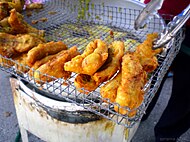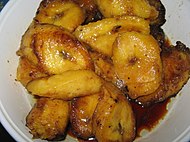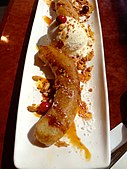Pisang goreng
It has been suggested that Pazham pori be merged into this article. (Discuss) Proposed since January 2021. |
It has been suggested that Kluai khaek be merged into this article. (Discuss) Proposed since January 2021. |
 Frying banana in Rantepao, Indonesia | |
| Alternative names | Fried banana |
|---|---|
| Type | Fritter |
| Region or state | Southeast Asia |
| Main ingredients | Banana, batter |
| Similar dishes | pritong saging |
Pisang goreng ('fried banana' in Indonesian/Malay)[1][2] is a fritter made by deep frying battered plantain in hot oil.[3] It is popular in Indonesia, Malaysia, Singapore,[4] and Brunei. It is typically consumed as a snack in the morning and afternoon.[5] In Indonesia and Malaysia, pisang goreng is often sold by street vendors,[6][7] although it is also offered as a product at storefronts and dining establishments.
Ingredients[]

Plantain is often used instead of banana. Traditionally, some cultivars of banana such as pisang raja, pisang tanduk and pisang kepok are the most popular kinds of banana used for pisang goreng. These banana cultivars have a mild sweet and sour flavor and firm texture that will not crumble upon being fried. Pisang raja however, has a softer texture and a fragrant aroma.[8] The banana is often battered and then deep fried in ample palm oil. Pisang goreng might be battered or plain deep fried. The batter most commonly uses a combination of flour, either wheat, rice flour, tapioca or bread crumb. Several recipes might add coconut milk or milk and vanilla extract into the batter to add aroma.[9]
Most traditional street vendors will then sell them as is, without any additional ingredients or toppings. However, fancy coffee shops, cafes and restaurants that serve pisang goreng are more sophisticated and present them in various ways, such as sprinkled with powdered sugar, cinnamon sugar, cheese, jam, condensed milk, chocolate or vanilla ice cream.[10]
Pisang goreng in Indonesia[]

In Indonesia, it is consumed as a snack to accompany tea or coffee,[11] either in the morning or late afternoon break. Traditional warung kopi (local coffee shops) often offer pisang goreng and other snacks, including fritters and kue to accompany coffee or tea.
In Indonesia, pisang goreng come under the category of gorengan (Indonesian: fritters, from goreng "to fry"), and many varieties are sold on travelling carts or by street vendors throughout Indonesia.[6] Other than pisang goreng, various kinds of ingredients are battered and deep fried such as tempeh, mendoan, tahu goreng (fried tofu), oncom, sweet potato, cassava chunk, cassava tapai, cireng (tapioca fritters), bakwan (flour with chopped vegetables) and breadfruit.[12]
Every regions in Indonesia has developed various recipe for pisang goreng with a variety of different names, ingredients and cooking techniques.[8] In Bali for example, pisang goreng is called godoh biu, in West Java it is called cau goreng, in Java gedhang goreng, in Sibolga pisang rakit and in Pontianak pisang kipas.[13]
Pisang goreng usually sold together with other gorengan fritters including fried tofu and tempeh. However, Pisang goreng Pontianak are widely popular in Indonesia with certain retail outlet exclusively sold only this type of fried banana.[14]
Variants[]


Indonesia has many varieties of pisang goreng, including:
- Pisang goreng kipas or Pisang goreng Pontianak
- Refers to banana cut in the shape of a fan, battered, and deep fried. The term pisang goreng Pontianak is often used interchangeably with pisang goreng kipas, as both have a similar fan-like shape, but the former is often filled or served with kaya jam.[8]
- Pisang goreng pasir
- Literally meaning "sandy fried banana", bread crumbs are added to the batter, resulting in grainy, crispy crumbs on the skin, making it have a similar texture to croquette.[8]
- Pisang goreng kremes
- Javanese pisang goreng kremes is quite similar to pisang goreng pasir, but with a different batter composition and a different frying technique. The batter coating is made of rice flour, vanilla extract, and coconut milk, deep fried in an ample of hot cooking oil, creating crispy and crunchy kremes granules in the coating, and resulting in a sweet, fragrant aroma.[8]
- Pisang goreng madu
- Literally meaning "honey fried banana", honey is added into the batter, and prior to serving honey is drizzled upon the fried banana. The color is rather dark due to the caramelised honey.[8]
- Pisang molen
- Derived from Dutch influence in Indonesia, pisang molen literally means "milled banana". Unlike other batter-coated pisang goreng, pisang molen is wrapped around in tape-shaped thin pastry dough prior to frying, creating a crunchy texture on the outside similar to pastry skin, while the banana inside remains moist and soft.[8]
- Pisang cokelat
- Often colloquially abbreviated as piscok, it is a thin crepe skin filled with banana and chocolate sprinkles or chocolate condensed milk, folded and deep fried in a similar fashion to making spring rolls. It is almost identical to the Filipino turon.
- Pisang nugget
- Small nugget-shaped fried banana. Its texture is akin to pisang goreng pasir in that it is coated in bread crumbs, however it is much smaller in size, similar in shape to chicken nuggets.[15]
- Pisang goreng telanjang
- Literally meaning "naked fried banana", it is fried without any batter. Salted butter or margarine are added,[8] and it may be topped with grated cheddar cheese. Pisang raja and pisang tanduk are the most suitable banana cultivars to be fried without batter.
- Pisang goreng Manado
- Manado pisang goreng is similar to other batter-coated pisang goreng, except it is served with sambal roa, a spicy chili paste made of smoked roa fish and fresh chilies.[8]
[]
Pisang goreng does not exist in the Philippines, unlike the rest of Maritime Southeast Asia, but there are numerous similar fried banana dishes. They are almost always made from saba bananas, a native cooking banana that is widely used in Filipino cuisine. The closest dish to pisang goreng is pritong saging, which is simply fried saba bananas (without batter) usually served with sugar or syrup. Bananas cooked with batter are a different dish known as maruya, which are more commonly made mashed or sliced very thinly and spread into a fan shape. However, the most common Filipino street food dishes made from banana are banana cue and turon. Banana cue are fried bananas coated with caramelized sugar and served on skewers; while turon is a type of fried dessert lumpia unique to the Philippines and is cooked in a crepe wrapper.
In Suriname this snack is also known as bakabana (meaning baked banana in Surinamese).[16]
In the Southern Indian state of Kerala it is known as Pazham pori.
In popular culture[]
- In 1993 film adaptation of 1948 Dutch novel Oeroeg that set in Indonesian National Revolution, the main character's friend, Twaan, expressed his amazement about the peculiarities of the Dutch East Indies people that consumes fried fruit; the pisang goreng or fried banana. The shout "pisang goreng!" later become a friendly salute among these comrades in arms.
Gallery[]
- Banana Fritter

Indonesian roadside gorengan (fritter) peddler offering pisang goreng.
Pisang goreng with paler batter.

Pisang tanduk goreng without batter.

Disc-shaped flat pisang goreng.

Pisang goreng with vanilla ice cream
See also[]
- Kluai khaek, Thai fried banana
- Chuối chiên, Vietnamese version of fried bananas
- Banana cue, Filipino version of fried bananas
- Fried plantain, African version of fried bananas
- List of banana dishes
- Pazham pori
References[]
- ^ Davidsen, Katherine (12 February 2013). Tuttle Compact Indonesian Dictionary: Indonesian-English English-Indonesian. Tuttle Publishing. ISBN 9781462910816.
- ^ Backshall, Stephen (2003). Indonesia. Rough Guides. ISBN 9781858289915.
- ^ The Oxford Companion to Sugar and Sweets. Oxford University Press.
- ^ Tay, Leslie. "Million Stars Goreng Pisang".
- ^ Visit Sabah, Malaysia Borneo Archived October 17, 2009, at the Wayback Machine
- ^ Jump up to: a b Kraig, Bruce; Sen, Colleen Taylor (9 September 2013). Street Food Around the World: An Encyclopedia of Food and Culture. ABC-CLIO. ISBN 9781598849554.
- ^ "GORENG PISANG: A STREET HAWKER DELIGHT IN PENANG, MALAYSIA Travel Blissful". travelblissful.com.
- ^ Jump up to: a b c d e f g h i Fauziah (7 July 2017). "All about Pisang Goreng". Indoindians. Retrieved 25 June 2018.
- ^ "Pisang Goreng (Indonesian Banana Fritters)". allrecipes.asia. Archived from the original on 22 September 2018. Retrieved 25 June 2018.
- ^ "Read Sylvia Halim's review of Bebek Tepi Sawah". Burpple. Retrieved 5 February 2020.
- ^ "Pisang Goreng (Indonesian Banana Fritters) with coffee or tea before the class begins - Picture of Lobong Culinary Experience, Ubud - TripAdvisor". www.tripadvisor.co.uk. Retrieved 25 June 2018.
- ^ Fauziah (2 June 2017). "Gorengan: Indonesia's Favorite Fried Snacks - Indoindians". Indoindians. Retrieved 27 June 2018.
- ^ "Resep Pisang Goreng - InfoReseps.com". inforesep.com. Archived from the original on 30 May 2013.
- ^ "Pisang Goreng Khas Pontianak Makin Banyak Peminat". Bisnis.com (in Indonesian). Retrieved 5 February 2020.
- ^ Media, Kompas Cyber. "Pisang Nugget Paling Tren di Pencarian Resep, Bagaimana Membuatnya? Halaman all". KOMPAS.com (in Indonesian). Retrieved 5 February 2020.
- ^ South American Food
External links[]
| Wikimedia Commons has media related to Pisang goreng. |
- Indonesian snack foods
- Malaysian snack foods
- Bruneian cuisine
- Philippine cuisine
- Singaporean cuisine
- Desserts
- Malay cuisine
- Malay words and phrases
- Banana dishes
- Vegetarian dishes of Indonesia
- Street food in Indonesia
- Burmese cuisine
- Fritters





